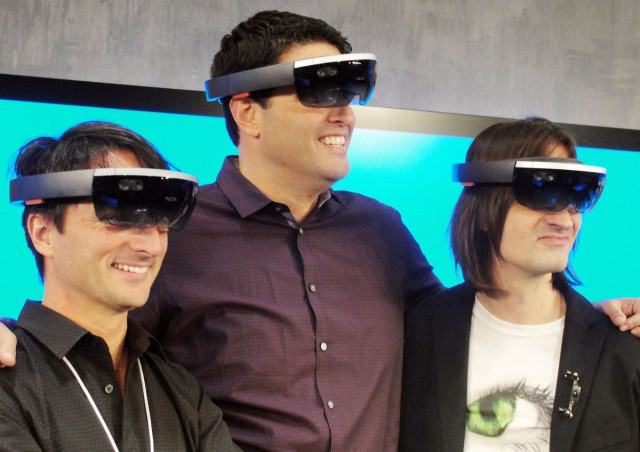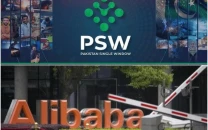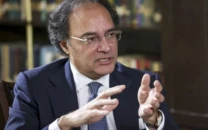Microsoft debuts virtual reality 'HoloLens'
Virtual assistant Cortana, its ability to answer questions conversationally, will now be now available on computers

Microsoft executives (L-R) Joe Belfiore, Terry Myerson and Alex Kipman pose with the HoloLens eyewear that overlays 3D images on the real world, at a press event at the technology titan's main campus in Redmond, Washington on January 21, 2015. PHOTO: AFP
The US technology titan debuted its HoloLens capabilities built into its coming Windows 10 operating system and showed off goggles that let wearers use their hands to interact with virtual objects. Halo now within reach.
"Until now, we've immersed ourselves in the world of technology," Microsoft's Alex Kipman said introducing HoloLens at a press event at the firm's headquarters in the state of Washington.
"But, what if we could take technology and immerse it in our world?"
Windows Holographic creates three-dimensional images in the real world, then lets people wearing the headgear reach out and manipulate virtual objects.
Kipman said he invited virtual reality innovators, including Facebook-owned Oculus VR, to explore adapting different applications for the goggles.
"Holograms can become part of our everyday life," he said.
Microsoft chief executive Satya Nadella touted HoloLens and Windows 10 as a "mind-blowing" experience that will open a new type of computing.
New Windows 10 weaves together Microsoft-powered devices
Microsoft pulled back the curtain Wednesday on a coming Windows 10 operating system focused on bringing harmony to the diverse array of Internet gadgets in people's lives.
The US technology titan is also trying to make it more natural to interact with devices, such as conversational-style speaking with the company's virtual assistant Cortana.
"The number of devices is just exploding around us," Microsoft's Terry Myerson said during a presentation to press and analysts at the company's headquarters in Redmond, Washington.
"It should be easy to put one device down and pick up another where you left off; technology needs to get out of the way."
Windows 10 is being designed with feedback from millions of "insiders" testing early versions of the operating system, Myerson said.
That feedback and design creates a foundation on which developers can build applications for smartphones, tablets, laptops, desktop computers, and Xbox One video game consoles, he said.
During the first year after the release of Windows 10, the operating system will be available as a free upgrade for computers running prior generation Windows 8.1 or Windows 7 software.
Microsoft said it will also keep Windows 10 upgraded during the lifetime of devices.
"Today is a big day for Windows," Nadella said as Microsoft provided a look at its latest operating system at its headquarters in Redmond, Washington.
"We want to move from people needing Windows, to choosing Windows, to loving Windows; that is our bold goal for Windows."
Personalised virtual assistant Cortana, and its touted ability to answer questions conversationally, will be now available on personal computers. Cortana made her debut on Windows-powered mobile devices.
Microsoft also unveiled a new Web browser code-named Spartan, which will have Cortana built in and ready to chime in at presumably helpful moments.
Spartan is poised to be the successor to Internet Explorer.
"Project Spartan is a new browsing experience tuned for being mobile and working across this family of devices," said Microsoft's Joe Belfiore.



















COMMENTS
Comments are moderated and generally will be posted if they are on-topic and not abusive.
For more information, please see our Comments FAQ